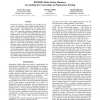412 search results - page 7 / 83 » A Structural Framework for Modeling Multi-Stage Network Atta... |
EDBT
2010
ACM
13 years 11 months ago
2010
ACM
With more and more social network data being released, protecting the sensitive information within social networks from leakage has become an important concern of publishers. Adve...
FMCO
2007
Springer
14 years 1 months ago
2007
Springer
As Internet applications become larger and more complex, the task of managing them becomes overwhelming. “Abnormal” events such as software updates, failures, attacks, and hots...
ACSC
2005
IEEE
14 years 1 months ago
2005
IEEE
We examine the robustness of critical infrastructure networks in the face of terrorist attack, using a simulation experiment that incorporates link capacity; and an extension of d...
AAAI
2012
11 years 10 months ago
2012
Penetration Testing is a methodology for assessing network security, by generating and executing possible hacking attacks. Doing so automatically allows for regular and systematic...
CCS
2010
ACM
13 years 7 months ago
2010
ACM
The ability to locate random relays is a key challenge for peer-to-peer (P2P) anonymous communication systems. Earlier attempts like Salsa and AP3 used distributed hash table look...

